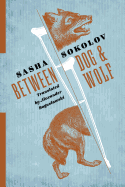
What do readers do when a work of literature is actively trying to trick them? Some books have twists and turns of plot, often with a stunning reveal, but they typically have resolutions, or at least some final thought for readers to depart with. But what about a work that has very little plot to speak of, or one whose plot points are entirely contradicted later in the text? Sasha Sokolov's Between Dog and Wolf (a French expression for "twilight," which is perfectly suited for this story) is uninterested in how readers typically engage with fiction. This dense novel (if it can even be called that) is about narrative itself, the act and its reception.
Written in 1980 and now translated into English, Between Dog and Wolf follows three narratives: one epistolary, one in dramatic third person and, lastly, the poetic musings of one of the protagonists (if anyone in the book can really be called that). All three sections are dynamic, filled with wordplay, portmanteaus and flights of fancy. It's rarely possible to see where the narrative is going. Instead, readers are taken on a literary ride, rolling through images and counter-images, stories and counter-stories that contradict their predecessors, until it finally ends with a poem that could either be read as a statement of purpose or just another game. Either way, it's one hell of a ride. --Noah Cruickshank, adult engagement manager, the Field Museum, Chicago, Ill.

